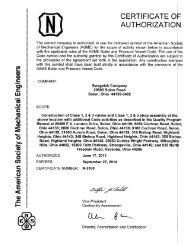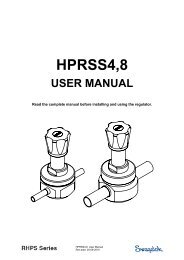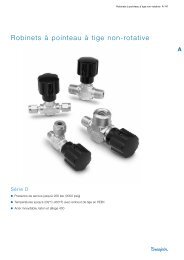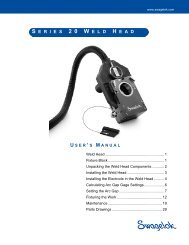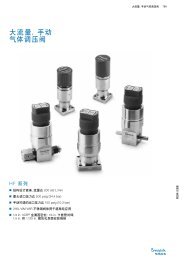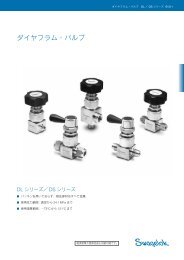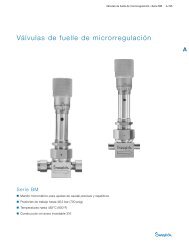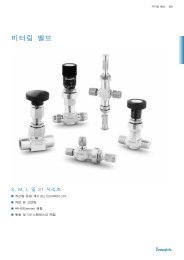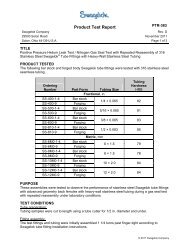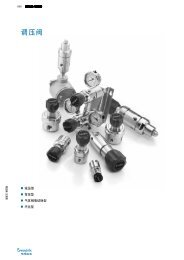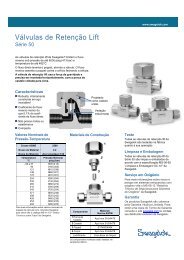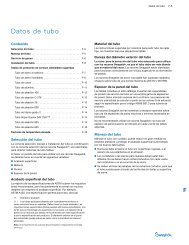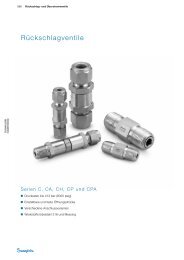Hose and Flexible Tubing (MS-01-180;rev_6;en-US) - Swagelok
Hose and Flexible Tubing (MS-01-180;rev_6;en-US) - Swagelok
Hose and Flexible Tubing (MS-01-180;rev_6;en-US) - Swagelok
Create successful ePaper yourself
Turn your PDF publications into a flip-book with our unique Google optimized e-Paper software.
<strong>Swagelok</strong> <strong>Hose</strong> <strong>and</strong> <strong>Flexible</strong> <strong>Tubing</strong> Installation <strong>and</strong> Use Guide<br />
<strong>Hose</strong> <strong>and</strong> <strong>Flexible</strong> <strong>Tubing</strong> 9<br />
Inspection<br />
Establish an inspection schedule based on system<br />
application <strong>and</strong> replacem<strong>en</strong>t history.<br />
Electrostatic Discharge<br />
Static electricity can be g<strong>en</strong>erated by fluid passing through<br />
the hose. Select hose with suffici<strong>en</strong>t conductivity to ground<br />
the static electric charge <strong>and</strong> allow static dissipation. If<br />
static electricity g<strong>en</strong>eration is possible within an application,<br />
choose static dissipative hose <strong>and</strong> properly ground to earth.<br />
Vibration<br />
Evaluate amount of system vibration wh<strong>en</strong> selecting hose.<br />
Metal hose may not be appropriate for systems with constant<br />
or severe vibration.<br />
L<strong>en</strong>gth<br />
Take into consideration hose movem<strong>en</strong>t, system<br />
pressurization, <strong>and</strong> thermal expansion wh<strong>en</strong> determining<br />
hose l<strong>en</strong>gth. Installing hose that does not have suffici<strong>en</strong>t<br />
l<strong>en</strong>gth to accommodate these factors may reduce hose life.<br />
Minimum B<strong>en</strong>d Radius<br />
Follow minimum b<strong>en</strong>d radius requirem<strong>en</strong>ts for your hose.<br />
Installing hose with smaller b<strong>en</strong>ds may kink hose <strong>and</strong> reduce<br />
hose life.<br />
Motion Absorption<br />
Distribute movem<strong>en</strong>t <strong>and</strong> p<strong>rev</strong><strong>en</strong>t b<strong>en</strong>ds smaller than the<br />
hose’s minimum b<strong>en</strong>d radius by providing suffici<strong>en</strong>t hose<br />
l<strong>en</strong>gth.<br />
Correct<br />
Machine Tolerance<br />
Allow for changes in l<strong>en</strong>gth resulting from machine motion<br />
<strong>and</strong> tolerances.<br />
Correct<br />
Incorrect<br />
Incorrect<br />
Minimum<br />
straight<br />
l<strong>en</strong>gth<br />
B<strong>en</strong>d<br />
radius<br />
System Pressure Changes<br />
Allow suffici<strong>en</strong>t hose l<strong>en</strong>gth to accommodate changing<br />
system pressures. Do not connect high- <strong>and</strong> low pressure<br />
hoses.<br />
motion absorption<br />
L<strong>en</strong>gth<strong>en</strong><br />
Correct<br />
Incorrect<br />
<strong>Hose</strong> rupture or leakage may result from b<strong>en</strong>ding too close to<br />
the hose/fitting connection.<br />
Short<strong>en</strong><br />
B<strong>en</strong>ding in One Plane<br />
Avoid twisting the hose by b<strong>en</strong>ding it in one plane only. For a<br />
machine pressure changes<br />
compound b<strong>en</strong>d, use multiple hose pieces or other isolation<br />
methods.<br />
Correct<br />
Incorrect<br />
<strong>Hose</strong> Strain<br />
Elbows <strong>and</strong> adapters can be used to relieve hose strain.<br />
minimum b<strong>en</strong>d radius<br />
system pressure changes<br />
minimum b<strong>en</strong>d radius<br />
Correct<br />
Incorrect<br />
Correct<br />
Incorrect<br />
For additional information, see SAE J1273, Recomm<strong>en</strong>ded<br />
Practices for Hydraulic <strong>Hose</strong> Assemblies.<br />
Images on this page reprinted with permission from SAE J1273.<br />
© 2009 SAE International.<br />
b<strong>en</strong>ding in one plane r2



